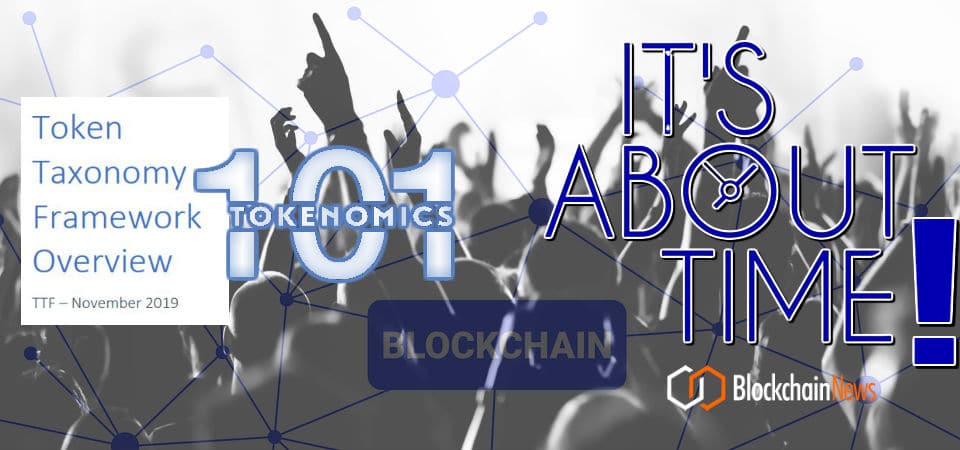The platform-neutral global group at Token Taxonomy Initiative (TTI) has rolled out the Token Taxonomy Framework (TTF) V 1.0 this week, enabling both businesses and developers to universally understand and define what a token is in non-technical terms, regardless of how it is implemented.
According to the framework overview, The framework’s purpose is to:
- Educate – take a step back and CLEARLY define a token in non-technical and cross-industry terms using real-world, everyday analogies so ANYONE can understand them via properties and behaviours that describe and define them.
- Define a common set of concepts and terms that can be used by business, technical, and regulatory participants to speak the same language.
- Produce token definitions that have clear and understood requirements that are implementation-neutral for developers to follow and standards organizations to validate.
- Establish a base Token Classification Hierarchy (TCH) driven by metadata that is simple to understand and navigate for anyone interested in learning and discovering tokens and underlying implementations.
- Deliver tooling meta-data using the TTF syntax that enables the generation of visual representations of classifications, and modelling tools to view and create token definitions mapped to the taxonomy.
- Use terminology that is neutral to programming language and blockchain, distributed ledger or other distributed medium where tokens reside.
- Encourage open and collaborative workshops to accelerate the creation of powerful vertical industry applications and innovation for platforms, start-ups, and enterprises.
- Produce standard artifacts and control message descriptions mapped to the taxonomy that are implementation-neutral and provide base components and controls that consortia, startups, platforms or regulators can use to work together.
- Encourage differentiation and vertical specialization while maintaining an interoperable base.
- Include a sandbox environment for legal and regulatory requirement discovery and input. Be used in taxonomy workshops for defining existing or new tokens which result in a contribution back to the framework to organically grow and expand across industries for maximum re-use.
It is NOT:
- Specific to the Ethereum family but applies to any shared medium – whether it be a
blockchain or database. - A legal or regulatory framework – but it does establish common ground.
- Complete or comprehensive. It is intended to be expanded over time.
Marley Gray, chair of the Token Taxonomy Initiative, EEA Board member and principal architect, Microsoft stated in a press release:
“Whether it’s a ticket, supply chain documents, stocks, property titles, loyalty points, or other as-yet unthought-of blockchain-based products and services, token use should be able to flow across platforms. If we want to take full advantage of what collaborative platforms have to offer, cross-platform transactions have to be able to communicate with one another. Standards are where that starts, and this Framework makes unlocking the untapped potential of tokens on the blockchain possible.”
“In practical terms, a business user or consortium can select a base type of token and choose from contributed lists of behaviours and properties and assign them to the token, just as you might drag and drop icons on a screen. The framework enables a business person to create a token visually using a design tool without writing any code whatsoever and allows them to tell developers, ‘I want one of these,’” said Gray.
Token Taxonomy Initiative members include Accenture, Adhara, Banco Santander, Blockchain Research Institute, Clearmatics, ConsenSys, Digital Asset, Envision Blockchain, EY, Hedera Hashgraph, IBM, Intel, ioBuilders, Itau, J.P. Morgan, Komgo, Microsoft, R3, and Web3 Labs, among others.
 “The Token Taxonomy Framework is the next step in creating a thriving tokenization ecosystem. By defining a common taxonomy for universal use, the Initiative will examine ways tokens can be applied across a wide variety of markets and any industry that values some collaboration among competing entities. The broad coalition of organizations that are part of this Initiative signals the strong commitment of the global enterprise community to come together around tokenization,” said Jeremy Millar, TTI member, a founding EEA member and chief of staff, ConsenSys.
“The Token Taxonomy Framework is the next step in creating a thriving tokenization ecosystem. By defining a common taxonomy for universal use, the Initiative will examine ways tokens can be applied across a wide variety of markets and any industry that values some collaboration among competing entities. The broad coalition of organizations that are part of this Initiative signals the strong commitment of the global enterprise community to come together around tokenization,” said Jeremy Millar, TTI member, a founding EEA member and chief of staff, ConsenSys.
The framework enables businesses to develop a clear definition and scope of the token concept, including use cases, taxonomy and terminology, and a specification neutral to the underlying technology – whether or not the token is hosted on a blockchain platform as it’s supported by taxonomy documentation and a set of tools that facilitate token definition workshops that contribute to a shared GitHub repository.
“We are seeing more enterprises take a keen interest in developing their own solution-specific tokenization schemes across a number of industries and use cases. We are pleased to be a member of the Token Taxonomy Initiative where we can share the collective experience of our own governing council members to further industry standards and best practices. These standards will enable custom token deployment across next-generation public ledgers that can meet increasingly demanding requirements for stability, security and performance in this emerging market,” said Brett McDowell, TTI member and executive director of Hedera Hashgraph Council.
Users of the universal platform can create new tokens from a set of reusable, cross-industry components, including existing token definitions, creating a specification that includes all of the business ingredients for any implementation.
“The Token Taxonomy Framework offers a way to classify tokens, and common language to describe them. This framework will help establish a foundation not only for technology and business, but for the changing regulatory landscape as well,” said Jerry Cuomo, TTI member, and vice president, IBM Blockchain. A technology-neutral Token Taxonomy Initiative is critical for the entire industry and IBM sees this as another important movement toward more open industry standards. The developers and organizations building the token networks of tomorrow, including IBM clients, will be the major beneficiaries.
“The standardization of blockchain tokens delivers a universal framework for enterprise customers to more easily define, design and implement token-based systems,” said Michael Reed, TTI member, EEA Board member and director of Intel’s Blockchain Program. “Together with hardware-based trusted execution environments, like Intel Software Guard Extensions technology, the industry can improve the efficiency of digital token issuance and management across enterprise blockchain networks.”
“As tokens become more widely adopted across the Corda ecosystem and beyond, R3 is excited to support the Token Taxonomy Initiative’s efforts to create common standards. The Token Taxonomy Framework will provide meaningful benefits to the industry as real-world applications move into production and gain traction around the world,” said TTI member and R3 Co-Founder Todd McDonald.
The use of standardized terms and definitions to both understand and build token-based systems, this global initiative will hopefully enable businesses and developers to universally design the next-generation of token-based business goods and services – without requiring an understanding of the morass of ridiculous industry jargon or scattered coding. You can view the TTF V 1.0 and draft specification documents on the TTI website.
- View the Token Taxonomy Framework V 1.0 and Specifications
- Participate in Shaping the Token Taxonomy Framework
“Companies and organizations are spending a lot of time trying to determine how best to tokenize products and services, especially identifying the shared properties and desired behaviour sets needed for implementation on existing blockchain platforms. Using the framework, businesspeople can describe a token that completely services their business requirements, while developers can see the types of backend requirements needed to standardize the token across different blockchain networks. The resulting token specification is a readable document that anyone can understand and download for documentation or education.”
One Framework for Multiple Platforms
The framework’s modular and template-based approach and token workshop facilitation tools are designed to make exploration and innovation as easy as possible. By using rich metadata, the framework facilitates automated code creation, verification, and certification that business users don’t necessarily need to understand – but is extremely valuable to developers. Using the GitHub repository, teams can map business requirements to specific blockchain code or solution implementations allowing for discovery and use in ways that help to increase time to market and expand the user base.
“Tokens have the potential to disrupt global economics and radically change how commerce will be transacted. The Token Taxonomy Initiative’s framework defines a standard taxonomy making it easier for all to create tokens to serve their respective business use cases,” said EEA Executive Director Ron Resnick. “While various implementations and taxonomies exist for tokens, the industry is currently lacking a venue for all participants to work together to describe how tokens can eventually interoperate across the multiple and disparate systems that make up a typical enterprise infrastructure. The TTF is now that venue. Plus, the EEA will be launching an EEA Token Working Group that will leverage the TTF framework to extend our global standards work.”
Specifically, the TTF framework provides:
- A common set of concepts and terms that can be used by business, technical, and regulatory participants so they can speak the same language
- A composition framework for defining and building tokens
- A Token Classification Hierarchy (TCH) that is simple to understand
- Tooling meta-data using the TTF syntax to be able to generate visual representations of classifications, and modeling tools to view and create token definitions mapped to the taxonomy – enabling linking with implementations for specific platforms
- A definition of tokens and their use cases across industries
- Example and real-world token specifications that are reusable, with parts portable across definitions from Adhara, ConsenSys, Digital Asset, Enterprise Ethereum Alliance (EEA), IBM, ioBuilders, Microsoft, and R3. Specific examples include:
- Adhara’s and ioBuilders’ EMoneyToken standard is being used in production payments and settlement systems
- Digital Asset will apply TTF standards to assets tokenized with DAML smart contracts
- Microsoft announced TTF support in Azure Blockchain Tokens, which simplifies the ability to define, create and manage compliant tokens based on TTF standards.
- Links to coded examples in a variety of languages to accelerate the movement from token definition to token implementation, regardless of platform
“The Token Taxonomy Framework is an important next step in enabling a technology-independent, open ecosystem of innovation across enterprise use cases. As a founding EEA member, Accenture is proud to be part of this important initiative. We look forward to collaborating with the other EEA members and helping organizations to identify opportunities to use this technology to drive real business transformation,” said David Treat, TTI member, a managing director and global blockchain lead at Accenture, and vice-chairman of the Board of the EEA.
“The concept of digital tokens has been given to us by the blockchain world, and it appears that in the coming years many different asset classes will be tokenized. As such, the Token Taxonomy Initiative’s framework will be key to ensuring that this next wave of financial innovation will start with cross-platform standards in mind,” said John Whelan, TTI member, chairman of the Board of the EEA, and head of Digital Investment Banking at Banco Santander.
The Token Taxonomy Initiative’s mission is to address the need to develop common definitions and scope for a business-grade standard for tokens with interchangeable currency-like properties or unique assets. Members of the initiative include Accenture, Adhara, Banco Santander, Blockchain Research Institute, Clearmatics, ConsenSys, Digital Asset, Envision Blockchain, EY, Hedera Hashgraph, IBM, Intel, ioBuilders, Itau, J.P. Morgan, Komgo, Microsoft, R3, and Web3 Labs, among others. EEA members can participate in the TTI by simply emailing the EEA Secretariat at secretariat@entethalliance.org. To learn more about the Token Taxonomy Initiative, please reach out to info@tokentaxonomy.org or visit https://tokentaxonomy.org.







